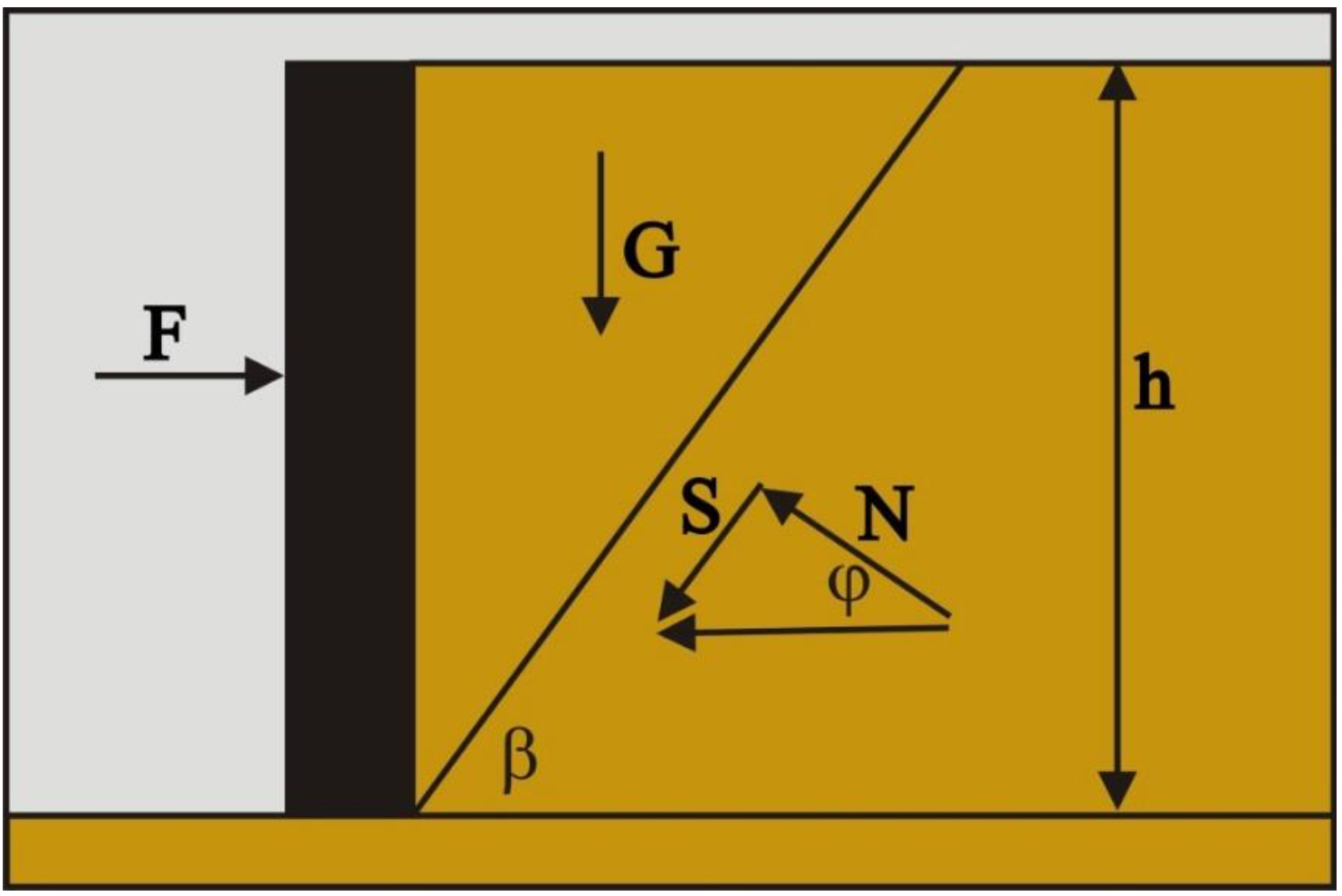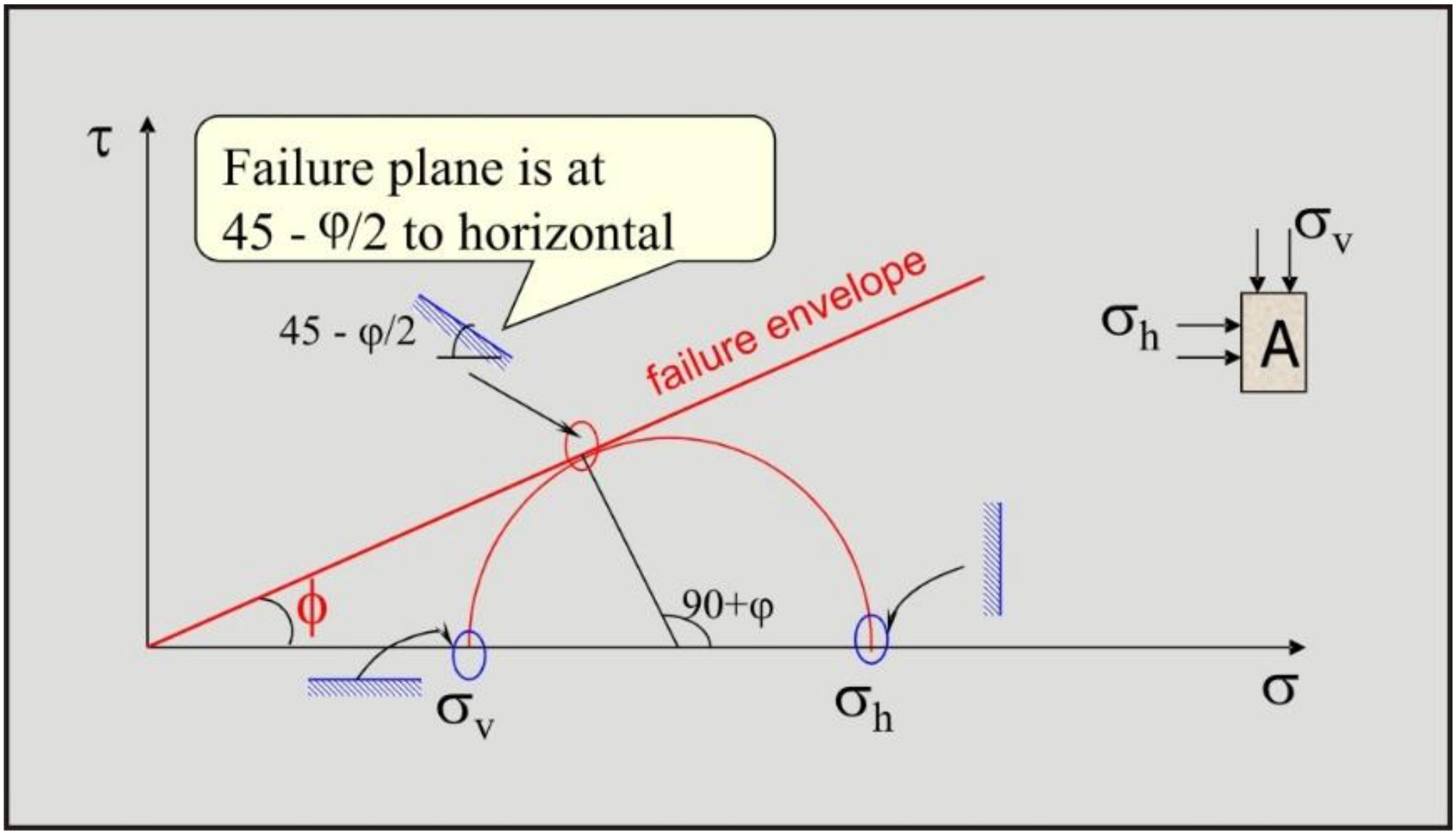2.10: Passive Soil Failure
- Page ID
- 33352
Passive soil failure is failure of the soil where the outside world takes action, for example a bulldozer. The standard example of passive soil failure is illustrated by the retaining wall example. A retaining wall has to push to supersede the forces exerted on it by the soil, in this case a sand with an internal friction angle φ. The retaining wall has to push strong enough to overcome the minimum possible occurring force. The height of the retaining wall is h. The problem has 4 unknowns; the force on the retaining wall F, the normal force on the shear plane N, the shear force on the shear plane S and the angle of the shear plane with the horizontal β. To solve this problem, 4 conditions (equations) have to be defined. The first equation is the relation between the normal force N and the shear force S. The second and third equations follow from the horizontal and vertical equilibrium of forces on the triangular wedge that will move upwards when the retaining wall pushes and the soil fails. The fourth condition follows from the fact that we search for the minimum possible force, a minimum will occur if the derivative of the force with respect to the angle of the shear plane is zero and the second derivative is positive. It should be mentioned that the direction of the shear force is always opposite to the possible direction of motion of the soil. Since the soil will move upwards because of the pushing retaining wall, the shear force is directed downwards.

To start solving the problem, first the weight of the triangular wedge of soil is determined according to:
\[\ \mathrm{G}=\frac{1}{2} \cdot \rho_{s} \cdot \mathrm{g} \cdot \mathrm{h}^{2} \cdot \cot (\beta) \cdot \mathrm{w}\tag{2-90}\]
The first relation necessary to solve the problem, the relation between the normal force and the shear force on the shear plane is:
\[\ \mathrm{S}=\mathrm{N} \cdot \tan (\varphi)\tag{2-91}\]
Further it is assumed that the soil consists of pure sand without cohesion and adhesion and it is assumed that the retaining wall is smooth, so no friction between the sand and the wall.
\[\ \begin{array}{left}\text{No cohesion}& \Rightarrow \mathrm{c}=\mathrm{0}\\
\text{No adhesion}& \Rightarrow \mathrm{a}=\mathrm{0}\\
\text{Smooth wall}& \Rightarrow \delta=\mathrm{0}\end{array}\tag{2-92}\]
This gives for the horizontal and vertical equilibrium equations on the triangular wedge:
\[\ \begin{array}{left}\text{Horizontal}& \Rightarrow \mathrm{F}-\mathrm{S} \cdot \cos (\beta)-\mathrm{N} \cdot \sin (\beta)=\mathrm{0}\\
\text{Vertical}& \Rightarrow \mathrm{G}-\mathrm{N} \cdot \cos (\beta)+\mathrm{S} \cdot \sin (\beta)=\mathrm{0}\end{array}\tag{2-93}\]
Substituting equation (2-91) gives:
\[\ \begin{array}{left} \mathrm{F}-\mathrm{N} \cdot \tan (\varphi) \cdot \cos (\beta)-\mathrm{N} \cdot \sin (\beta)=0\\
\mathrm{G}-\mathrm{N} \cdot \cos (\beta)+\mathrm{N} \cdot \tan (\varphi) \cdot \sin (\beta)=0\end{array}\tag{2-94}\]
Writing the full tangent and multiplying with cos(φ) gives:
\[\ \begin{array}{left}\mathrm{F} \cdot \cos (\varphi)-\mathrm{N} \cdot \sin (\varphi) \cdot \cos (\beta)-\mathrm{N} \cdot \sin (\beta) \cdot \cos (\varphi)=0\\
\mathrm{G} \cdot \cos (\varphi)-\mathrm{N} \cdot \cos (\beta) \cdot \cos (\varphi)+\mathrm{N} \cdot \sin (\varphi) \cdot \sin (\beta)=0\end{array}\tag{2-95}\]
Now the terms with the normal force N can be combined to:
\[\ \begin{array}{left}\mathrm{F} \cdot \cos (\varphi)-\mathrm{N} \cdot \sin (\varphi+\beta)=\mathrm{0}\\
\mathrm{G} \cdot \cos (\varphi)-\mathrm{N} \cdot \cos (\varphi+\beta)=\mathrm{0}\end{array}\tag{2-96}\]
Cross multiplying with sine and cosine to give the normal force the same terms:
\[\ \begin{array}{left}\mathrm{F} \cdot \cos (\varphi) \cdot \cos (\varphi+\beta)-\mathrm{N} \cdot \sin (\varphi+\beta) \cdot \cos (\varphi+\beta)=0\\
-\mathrm{G} \cdot \cos (\varphi) \cdot \sin (\varphi+\beta)+\mathrm{N} \cdot \cos (\varphi+\beta) \cdot \sin (\varphi+\beta)=0\end{array}\tag{2-97}\]
Adding up the two equations gives:
\[\ \mathrm{F} \cdot \cos (\varphi) \cdot \cos (\varphi+\beta)=\mathrm{G} \cdot \cos (\varphi) \cdot \sin (\varphi+\beta)\tag{2-98}\]
Solving the first 3 equations with the first 3 unknowns gives for the force on the retaining wall:
\[\ \mathrm{F}=\mathrm{G} \cdot \tan (\varphi+\beta)\tag{2-99}\]
With the equation for the weight of the sand.
\[\ \mathrm{G}=\frac{1}{2} \cdot \rho_{\mathrm{s}} \cdot \mathrm{g} \cdot \mathrm{h}^{2} \cdot \cot (\beta) \cdot \mathrm{w}\tag{2-100}\]
The equation for the force on the retaining wall is found.
\[\ \mathrm{F}=\frac{1}{2} \cdot \rho_{\mathrm{s}} \cdot \mathrm{g} \cdot \mathrm{h}^{2} \cdot \frac{\cos (\beta) \cdot \sin (\varphi+\beta)}{\sin (\beta) \cdot \cos (\varphi+\beta)} \cdot \mathrm{w}\tag{2-101}\]
This equation still contains the angle of the shear plane as an unknown. Since we are looking for the minimum possible force, a value for β has to be found where this force reaches a minimum. The derivative of the force and the second derivative have to be determined.
\[\ \frac{\mathrm{d} \mathrm{F}}{\mathrm{d} \beta}=\mathrm{0}\tag{2-102}\]
\[\ \frac{\mathrm{d}^{2} \mathrm{F}}{\mathrm{d} \beta^{2}}>\mathrm{0}\tag{2-103}\]
Since the equation of the force on the retaining wall contains this angle both in the nominator and the denominator, determining the derivative may be complicated. It is easier to simplify the equation with the following trick:
\[\ \begin{array}{left}\frac{\cos (\beta) \cdot \sin (\varphi+\beta)}{\sin (\beta) \cdot \cos (\varphi+\beta)}=\frac{\cos (\beta) \cdot \sin (\varphi+\beta)}{\sin (\beta) \cdot \cos (\varphi+\beta)}-1+1\\
=\frac{\cos (\beta) \cdot \sin (\varphi+\beta)}{\sin (\beta) \cdot \cos (\varphi+\beta)}-\frac{\sin (\beta) \cdot \cos (\varphi+\beta)}{\sin (\beta) \cdot \cos (\varphi+\beta)}+1\\
=\frac{\cos (-\beta) \cdot \sin (\varphi+\beta)}{\sin (\beta) \cdot \cos (\varphi+\beta)}+\frac{\sin (-\beta) \cdot \cos (\varphi+\beta)}{\sin (\beta) \cdot \cos (\varphi+\beta)}+1\\
=1+\frac{\sin (\varphi)}{\sin (\beta) \cdot \cos (\varphi+\beta)}\end{array}\tag{2-104}\]
Substituting this result in the equation for the force on the retaining wall gives:
\[\ \mathrm{F}=\frac{\mathrm{1}}{2} \cdot \rho_{\mathrm{s}} \cdot \mathrm{g} \cdot \mathrm{h}^{2} \cdot\left(1+\frac{\sin (\varphi)}{\sin (\beta) \cdot \cos (\varphi+\beta)}\right) \cdot \mathrm{w}\tag{2-105}\]
When the denominator in the term between brackets has a maximum, also the whole equation has a minimum. So we have to find the maximum of this denominator.
\[\ \mathrm{f}=\sin (\beta) \cdot \cos (\beta+\varphi) \Rightarrow\text{ F minimum if } \mathrm{f} \text{ maximum}\tag{2-106}\]
The first derivative of this denominator with respect to the shear angle is:
\[\ \frac{\mathrm{d f}}{\mathrm{d} \beta}=\cos (2 \cdot \beta+\varphi)\tag{2-107}\]
The second derivative of this denominator with respect to the shear angle is:
\[\ \frac{\mathrm{d}^{2} \mathrm{f}}{\mathrm{d} \boldsymbol{\beta}^{2}}=-\mathrm{2} \cdot \sin (\mathrm{2} \cdot \boldsymbol{\beta}+\varphi)\tag{2-108}\]
The first derivative is zero when the shear angle equals 45 degrees minus half the internal friction angle:
\[\ \frac{\mathrm{d f}}{\mathrm{d} \beta}=\mathrm{0} \Rightarrow \beta=\frac{\pi}{4}-\frac{1}{2} \cdot \varphi\tag{2-109}\]
Substituting this solution in the equation for the second derivative gives a negative second derivative which shows that a maximum has been found.
\[\ \frac{\mathrm{d}^{2} \mathrm{f}}{\mathrm{d} \beta^{2}}=-2\text{ for }\beta=\frac{\pi}{4}-\frac{1}{2} \cdot \varphi\tag{2-110}\]
Substituting this solution for the shear plane angle in the equation for the force on the retaining wall gives:
\[\ \mathrm{F}=\frac{\mathrm{1}}{2} \cdot \rho_{\mathrm{s}} \cdot \mathrm{g} \cdot \mathrm{h}^{2} \cdot\left(\frac{\mathrm{1}+\sin (\varphi)}{1-\sin (\varphi)}\right) \cdot \mathrm{w}=\frac{\mathrm{1}}{2} \cdot \rho_{\mathrm{s}} \cdot \mathrm{g} \cdot \mathrm{h}^{2} \cdot \mathrm{w} \cdot \mathrm{K}_{\mathrm{p}}\tag{2-111}\]
The factor Kp is often referred to as the coefficient of passive failure, which is larger than 1. In the case of a 30 degrees internal friction angle, the value is 3.
\[\ \mathrm{K_{P}=\frac{1+\sin \varphi}{1-\sin \varphi}=\tan ^{2}(45+\varphi / 2)}\tag{2-112}\]
The horizontal stresses equal the vertical stresses times the factor of passive failure, which means that the horizontal stresses are larger than the vertical stresses.
\[\ \sigma_{\mathrm{h}}=\mathrm{K}_{\mathrm{p}} \cdot \sigma_{\mathrm{v}}\tag{2-113}\]



